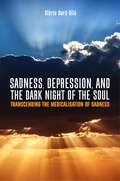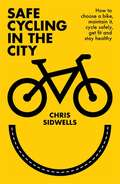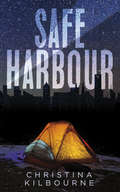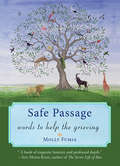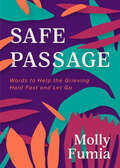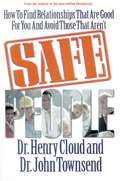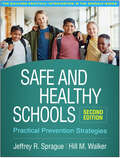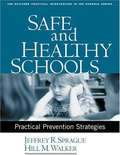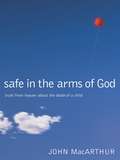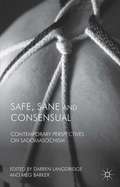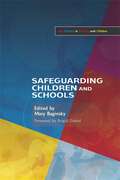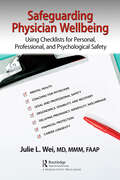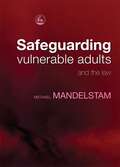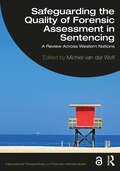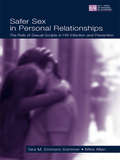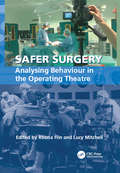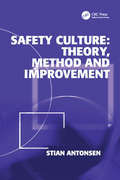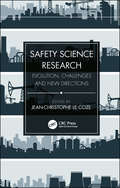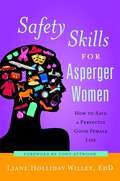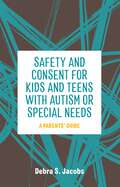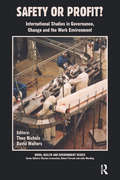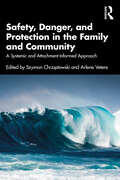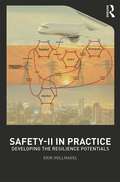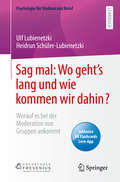- Table View
- List View
Sadness, Depression, and the Dark Night of the Soul: Transcending the Medicalisation of Sadness
by Glòria Durà-VilàThis ground-breaking book contemplates how some religious individuals and communities conceptualise severe sadness and emotional distress, which might otherwise be described as pathological, as an essential ingredient for spiritual development. It explores the implications this may have for clergy and psychiatrists seeking to understand sadness.
Safe Cycling in the City: How to choose a bike, maintain it, cycle safely, get fit and stay healthy
by Chris SidwellsThis is an urban and commuting cyclist's handbook, both inspirational and practical, showing us how to live safer, more enjoyable and healthier lives, both physically and mentally, while reducing our impact on the planet.Author of numerous bestselling bike books, Chris Sidwells, begins with a brief introduction which shows how cycling is already forming a crucial part of future urban transport, good for the environment as well as our health. Current urban transport models, heavily dependent as they are on cars, are unsustainable both in terms of our health and the environment. Cycling offers the perfect mass transport, health and wellbeing solution. As well as being an easy way to improve the fitness of the whole family, with some simple know-how, which Chris shares in this book, it can be perfectly safe even in busy cities. Increasingly, local authorities are seeing the essential role that cycling has to play in transport infrastructure; Chris looks at the many different schemes, both financial and infrastructural, to encourage people onto bikes. Commuting by bike also offers a financial benefit to individuals and societies.Chris shows how to get the right bike for you for commuting and urban cycling, whether that's an electric-assisted bike or pedal-powered only, and how to adjust it properly for your unique build. He looks at cycling clothing and accessories, including helmets, masks, locks and safety equipment. Chris explains how to keep cycling safely despite inclement weather and the different ways to transport what you need to and from work. A chapter on bike care and maintenance shows how to carry out basic repair jobs like adjusting gears, mending punctures and adjusting brakes.Chris explains cycling skills to give you confidence when cycling, including bike control, braking and how to make the most of your gears. He shows when and how to use the extra power provided by an electric bike and offers encouragement to new and returning cyclists.An extended chapter covers road safety, perhaps the biggest barrier to people commuting by bike. Chris shows how to co-exist safely with other road users and the potential hazards that every cyclist should be aware of. He explains the rules that every cyclist must follow and gives step-by-step guidance on how to carry out manoeuvres on the road.Chris shows how to choose the best route to and from work. He gives details of the various schemes to encourage commuting by bike, including insurance and where to find information.Cycling is regarded by many as the best way to regain and maintain fitness. As well as improving both physical and mental wellbeing, cycling can boost our immune system. Cycling also gives self-sufficiency and enhances self esteem.
Safe Cycling in the City: How to choose a bike, maintain it, cycle safely, get fit and stay healthy
by Chris SidwellsThis is an urban and commuting cyclist's handbook, both inspirational and practical, showing us how to live safer, more enjoyable and healthier lives, both physically and mentally, while reducing our impact on the planet.Author of numerous bestselling bike books, Chris Sidwells, begins with a brief introduction which shows how cycling is already forming a crucial part of future urban transport, good for the environment as well as our health. Current urban transport models, heavily dependent as they are on cars, are unsustainable both in terms of our health and the environment. Cycling offers the perfect mass transport, health and wellbeing solution. As well as being an easy way to improve the fitness of the whole family, with some simple know-how, which Chris shares in this book, it can be perfectly safe even in busy cities. Increasingly, local authorities are seeing the essential role that cycling has to play in transport infrastructure; Chris looks at the many different schemes, both financial and infrastructural, to encourage people onto bikes. Commuting by bike also offers a financial benefit to individuals and societies.Chris shows how to get the right bike for you for commuting and urban cycling, whether that's an electric-assisted bike or pedal-powered only, and how to adjust it properly for your unique build. He looks at cycling clothing and accessories, including helmets, masks, locks and safety equipment. Chris explains how to keep cycling safely despite inclement weather and the different ways to transport what you need to and from work. A chapter on bike care and maintenance shows how to carry out basic repair jobs like adjusting gears, mending punctures and adjusting brakes.Chris explains cycling skills to give you confidence when cycling, including bike control, braking and how to make the most of your gears. He shows when and how to use the extra power provided by an electric bike and offers encouragement to new and returning cyclists.An extended chapter covers road safety, perhaps the biggest barrier to people commuting by bike. Chris shows how to co-exist safely with other road users and the potential hazards that every cyclist should be aware of. He explains the rules that every cyclist must follow and gives step-by-step guidance on how to carry out manoeuvres on the road.Chris shows how to choose the best route to and from work. He gives details of the various schemes to encourage commuting by bike, including insurance and where to find information.Cycling is regarded by many as the best way to regain and maintain fitness. As well as improving both physical and mental wellbeing, cycling can boost our immune system. Cycling also gives self-sufficiency and enhances self esteem.
Safe Harbour
by Christina KilbourneAs crazy as her father’s plan sounds, sticking to it is easy for Harbour — until it isn’t. Fourteen-year-old Harbour is living in a tent in a Toronto ravine with her dog, a two-month supply of canned tuna, and an unconventional reading list. She’s not homeless, she tells herself. She’s merely waiting for her home — a thirty-six-foot sailboat — to arrive with her father at the helm. Why should she worry when the clouds give her signs that assure her that she’s safe and protected? When her credit card gets declined, phone contact from her father stops, and summer slips into a frosty fall, Harbour is forced to face reality and accept the help of a homeless teen named Lise to survive on the streets. Lise shows Harbour how to panhandle and navigate the shelter system while trying to unravel Harbour's mysterious past. But if Harbour tells her anything, the consequences could be catastrophic.
Safe Passage: Words to Help the Grieving (Words To Help The Grieving Hold Fast And Let Go Ser.)
by Molly FumiaThis compassionate guide through the grieving process offers wisdom, hope, and healing meditations for those facing a difficult loss. The losses we face impact us in different ways, but there are certain steps we naturally take on a journey that ultimately leads to healing. A grief expert who has experienced devastating loss, Molly Fumia offers wisdom and insight to accompany us through these steps in this grief recovery handbook. As Fumia explains, the grieving process is a slow one, but it is only by going through each of the steps that recovery is achieved. With this in mind, she provides meditative reflections for readers to sit with. By encouraging us to take the necessary time to contemplate our feelings, Fumia opens a space for us to face our grief and equips us to handle what comes with that challenge. Fumia provides a deeply thoughtful roadmap for the difficult journey we face after profound loss in our lives. In leading us through the stages of grief, from near disbelief and denial to acceptance and growth, this meditation book provides a helping hand to all those lost in grief.
Safe Passage: Words to Help the Grieving Hold Fast and Let Go
by Molly FumiaComfort Words for Loss, Grief, and Bereavement“Here is a book of exquisite honesty and profound depth. Along the way, grief becomes a dance in the dark and suffering turns to love”—Sue Monk Kidd, Author of The Secret life of Bees and The Dance of the Dissident DaughterToo many of us are familiar with the feelings of grief and bereavement. For those new to and for those long suffering from loss, Safe Passage is a grief handbook to heal loss of every kind.One of the best books on grieving. The grieving process is slow, but each step is necessary for recovery. In this classic grief and loss book with over 100,000 copies sold, Molly Fumia says it's ok that you're not ok, and gently guides us through any stage of grief with her profound wisdom and insight. Her kind comfort words for loss and encouragement helps us to contemplate our feelings and creates a space where healing your mind and soul is possible—even after loss.Find healing and hope. Healing grief can seem impossible, but Fumia assures us that there is hope to be found. As an expert on grief, and as someone who has experienced devastating loss, Fumia provides a deeply thoughtful roadmap for the difficult journey we face when bearing the unbearable. In leading us through the pain of grief and grieving, this book on grieving provides a helping hand to all those lost in grief.Inside Safe Passage, find:Steps to guide you through each stage of griefComfort words for loss from a critically acclaimed grief expertA grief handbook for healing grief, finding peace in the everyday process of griefIf you found comfort in books on grieving like Grief Is Love, The Grieving Brain, or Things I Wish I Knew Before My Mom Died, you’ll love Safe Passage.
Safe People: How to Find Relationships That Are Good for You and Avoid Those That Aren't
by John D. Townsend Henry CloudFinding safe people provides the foundation for building healthy, lasting relationships. Here's how to identify safe people.
Safe and Healthy Schools, Second Edition: Practical Prevention Strategies (The Guilford Practical Intervention in the Schools Series)
by Jeffrey R. Sprague Hill M. WalkerNow in a fully revised and updated second edition, this authoritative resource provides a complete toolkit for designing and implementing an evidence-based school safety plan. Foremost experts guide practitioners to understand and prevent violence, bullying, and peer harassment in grades K–12. Best practices are reviewed for creating a positive school climate and establishing effective security and crisis response procedures. The authors describe ways to identify and support behaviorally at-risk students across multiple tiers of intervention, beginning with universal screening. In a convenient large-size format, the book includes reproducible planning tools. Purchasers get access to a Web page where they can download and print the reproducible materials. New to This Edition *Reflects over 15 years of research advances, new initiatives, and the growth of universal prevention models. *Grounded in current positive behavioral interventions and supports (PBIS) practices; also incorporates restorative discipline, social–emotional learning, and trauma-informed practices. *State-of-the-art behavioral screening and threat assessment methods are integrated throughout. *Discussions of timely topics, including cyberbullying, the role and limitations of policing in schools, and racial/ethnic disparities in discipline. This book is in The Guilford Practical Intervention in the Schools Series, edited by Sandra M. Chafouleas.
Safe and Healthy Schools: Practical Prevention Strategies
by Jeffrey R. Sprague Hill M. WalkerA hands-on resource for practitioners, this book provides step-by-step guidance for developing a comprehensive school safety plan. Moving from needs assessment to implementation and evaluation, chapters describe research-based strategies that are readily applicable in K-12 settings. Special features include reproducible checklists and other planning tools, presented in a large-size format with convenient lay-flat binding. Described are proven ways to: * Create a low-crime environment * Identify and support high-risk students * Reduce bullying and harassment * Improve the schoolwide disciplinary system * Draw on community resources for change
Safe in the Arms of God
by John Macarthur"Is my baby in heaven?"This is the most important question a grieving parent can ask. And even if the little one is someone else's child, the issue remains: What happens to children-those unborn, stillborn, or youngsters-when they die? Can you hope to see them again? Can you let go of your fear and guilt? Can God's love soothe a wound so jagged?With scriptural authority and the warmth of a pastor's heart, bestselling author John MacArthur examines the breadth of the entire Bible and reveals in this compelling book the Heavenly Father's care for every life."I have sat by the grave of our daughter and son and wondered out loud if my belief that Hope and Gabriel are in heaven has any solid scriptural support. John MacArthur offers truth from God's Word that puts the doubts of any grieving parent to rest. Safe in the Arms of God reveals that confidence of heaven for the child you love is based on much more than mere sentimentality; it is revealed in the Word of God and reflective of the very heart of God." -Nancy Guthrie, author of Holding On to Hope
Safe, Sane and Consensual: Contemporary Perspectives on Sadomasochism
by Meg John Barker Darren LangdridgePsychological and medical perspectives on sadomasochism (SM) have historically been concerned with understanding it as a form of psychopathology. In the past (but still often today) studies of SM have been concerned with extreme and most often non-consensual acts. More recently, however, there has been growing interest in exploring the meaning of sadomasochism in non-pathological ways. This book includes work from across the social sciences exploring a variety of aspects of SM from a non-pathological perspective. There are discussions of the history and culture of SM, medical and legal understandings, along with theory and original research on the topic. There are also sections on SM and psychotherapy and writing on bridging the academic/activist divide. This book, now in paperback with a new introduction, includes contributions from an international group of academics, practitioners and activists and represents some of the most recent cutting edge work in the field by leading scholars.
Safeguarding Children and Schools
by David Miller John Guest Yvonne Coppard Brigid Daniel Graham Music Simon Hackett Ken Mcculloch Mary Baginsky Susan Mcginnis Ann Raymond Louise Laskey Abigail Taylor Enid Hendry Felicity Fletcher-Campbell William Baginsky Lyn Tett Emma WestcottSafeguarding Children and Schools explains how schools are able to contribute to keeping children safe from harm and promoting their welfare, in line with Government Every Child Matters guidelines. The contributors, who are all experts in the field of child protection, put the potentially daunting task faced by schools in context, explaining relevant policy, the latest research findings and offering practical examples to help schools to be more proactive and meet their responsibilities successfully. Areas discussed include the roles of local education authority services and schools in child protection, working with particularly vulnerable or difficult children, the relationship between safeguarding and the curriculum, and training school staff to safeguard children. At a time when expectations of the role of schools are evolving, this book provides guidance and support for teachers, managers and social care professionals. Best Practice in Working with Children Series Edited by Brigid Daniel, Professor of Social Work, Department of Applied Social Science, University of Stirling The titles in the Best Practice in Working with Children series are written for the multi-agency professionals working to promote children's welfare and protect them from harm. Each book in the series draws on current research into what works best for children, providing practical, realistic suggestions as to how practitioners in social work, health and education can work together to promote the resilience and safety of the children in their care. Brigid Daniel is Professor of Social Work in the Department of Applied Social Science at the University of Stirling. She is co-author of several textbooks and practice resources on child care and protection. She was a member of the multi-disciplinary team that carried out a national ministerial review of child protection practice in Scotland.
Safeguarding Physician Wellbeing: Using Checklists for Personal, Professional, and Psychological Safety
by Julie L. WeiThe United States is facing a worsening epidemic of physician burnout with unprecedented numbers of them leaving the workforce and practice of clinical medicine across all career stages. The prevalence of physician burnout has accelerated through COVID-19, resulting in an anticipated serious national shortage of physicians within the current decade amidst an increased proportion of aging and unhealthy population. The critical shortage of physicians coupled with an unhealthy physician workforce results in longer wait times for access, continued increased healthcare costs, decreased quality of care, and worsening patient experience. Despite increasing media coverage, published data, and identification of system-based factors that erode physician wellbeing, no standardized systematic solution has been implemented across hospitals, health systems, or a variety of employment models or practice settings for any or all doctors regardless of whether they are primary care, medical, or surgical subspecialists. Effective solutions to mitigate physician burnout, protect current working physicians, and keep them from leaving medicine require a SHIFT and a more individualized approach. Many proposed academic models address system-based factors, but such solutions depend greatly on those who employ doctors. Executive leadership in charge of healthcare systems are often challenged by physician burnout and their desired autonomy, against the need for standardization of care delivery to improve quality and decrease cost. Physician productivity measures continue to be based on data samples of physician compensation surveys supplied by companies like Sullivan Cotter or Medical Group Management Association (MGMA). Such benchmarks are commonly used but data may not reflect specific realities for any organizations nor the rapid changes in the landscape of US healthcare amidst mergers, acquisitions, consolidation, and shifts in employment models from insurance and online retail giants and private equity. This book uses a "checklist" approach to empower any medical student, resident, fellow, or practicing physician to create and experience psychological, personal, and professional safety and wellbeing. Not only can individual physicians choose and use these checklists themselves, but those who live with, love, and cherish one or more physicians in their families and/or lives can use this book to understand physician realities and their risks.
Safeguarding Vulnerable Adults and the Law
by Michael MandelstamThe protection of vulnerable adults is a fast emerging area of work for local authorities, the NHS and other agencies. Safeguarding Vulnerable Adults and the Law, sets this within a comprehensive legal framework. The relevant law and guidance is extensive. It includes Department of Health guidance (No Secrets), human rights, the regulation of health and social care providers, the barring of carers from working with vulnerable adults, care standards tribunal cases, mental capacity, undue influence, assault, battery, wilful neglect, ill treatment, manslaughter, murder, theft, fraud, sexual offences, data protection and the sharing of information. The book focuses on how these areas of law apply to vulnerable adults, and brings together an extensive body of case law to illustrate this. Also covered is how local authorities and the NHS may themselves be implicated in the harm - through abuse, neglect or omission - suffered by vulnerable adults. For example, in terms of the gross lapses in standards of care, infection control, nutrition and basic dignity sometimes to be found in hospitals. All those working in community care, adult social work, health care and housing will find this book invaluable. Local authorities, the NHS, voluntary organisations and students will find this to be essential reading.
Safeguarding the Quality of Forensic Assessment in Sentencing: A Review Across Western Nations (International Perspectives on Forensic Mental Health)
by van der Wolf, MichielThis edited collection provides an interdisciplinary and cross-national perspective on safeguarding the quality of forensic assessment in sentencing offenders. Taking an in-depth look at seven different Western countries, each chapter provides an overview of the role of assessment in sentencing offenders, as well as a focus on formal ways in which the respective country’s legal system and disciplinary associations protect the quality of forensic assessment. Each chapter explores how to assure better decision making in individual cases based on assessments of psycholegal concepts such as mental disorder/insanity, criminal responsibility and dangerousness. Combining the perspectives of lawyers, legal scholars, and clinicians working in the field, this book is essential for those working in and with forensic assessment.
Safer Sex in Personal Relationships: The Role of Sexual Scripts in HIV Infection and Prevention (LEA's Series on Personal Relationships)
by Mike Allen Tara M. Emmers-SommerThis book focuses on safer sex discussion and practice in close, personal relationships, emphasizing research on individuals in personal relationship types that are experiencing a rise in HIV infection and AIDS. Moving beyond studies of gay adult males and IV drug-users, this work paints a clear picture of the very real risk that exists for these less-studied, more general populations, so individuals may better personalize the risk and engage in more preventative measures. Authors Tara M. Emmers-Sommer and Mike Allen examine issues surrounding safer sex, utilizing research that focuses on how individuals struggle with personalizing the HIV and AIDS risk and how they cope with safer sex issues.Safer Sex in Personal Relationships takes readers on a journey through a variety of close relationship types. It begins by highlighting awareness to the global enormity of HIV and AIDS and providing a link between the global and personal, and the need to make HIV and AIDS awareness part of everyday talk and personal relationship structure. It then focuses on:*safer sex in close relationships, both heterosexual and homosexual;*marital relationships and the importance of safe sex discussion and awareness in marriages;*HIV and AIDS from a multicultural perspective;*HIV and AIDS in aged populations; and*increasing awareness, understanding, and compassion of those living with HIV and AIDS.This book will appeal to scholars and students concerned with HIV and AIDS in personal relationships. It will be an invaluable text for courses on interpersonal communication and relationships; family, marital, human sexuality, sex and gender, gay and lesbian relationships, and sexual education; and relational conflict across communication, psychology, and sociology disciplines.
Safer Surgery: Analysing Behaviour in the Operating Theatre
by Lucy Mitchell Rhona FlinOperating theatres are very private workplaces. There have been few research investigations into how highly trained doctors and nurses work together to achieve safe and efficient anaesthesia and surgery. While there have been major advances in surgical and anaesthetic procedures, there are still significant risks for patients during operations and adverse events are not unknown. Due to rising concern about patient safety, surgeons and anaesthetists have looked for ways of minimising adverse events. Behavioural scientists have been encouraged by clinicians to bring research techniques used in other industries into the operating theatre in order to study the behaviour of surgeons, nurses and anaesthetists. Safer Surgery presents one of the first collections of studies designed to understand the factors influencing safe and efficient surgical, anaesthetic and nursing practice. The book is written by psychologists, surgeons and anaesthetists, whose contributions combine to offer readers the latest research techniques and findings from some of the leading investigators in this field. It is designed for practitioners and researchers interested in understanding the behaviour of operating theatre team members, with a view to enhancing both training and practice. The material is also suitable for those studying behaviour in other areas of healthcare or in high-risk work settings. The aims of the book are to: a) present the latest research on the behaviour of operating theatre teams b) describe the techniques being used by psychologists and clinicians to study surgeons, anaesthetists and theatre nurses' task performance c) outline the safety implications of the research to date.
Safety Culture: Theory Method And Improvement
by Stian AntonsenThe aim of this book is to show how a cultural approach can contribute to the assessment, description and improvement of safety conditions in organizations. The relationship between organizational culture and safety, epitomized through the concept of 'safety culture', has undoubtedly become one of the hottest topics of both safety research and practical efforts to improve safety. By combining a general framework and five research projects, the author explores and further develops the theoretical, methodological and practical basis of the study of safety culture. What are the theoretical foundations of a cultural approach to safety? How can the relationship between organizational culture and safety be empirically investigated? What are the links between organizational culture and safety in actual organizations? How can a cultural approach contribute to the improvement of safety? These are the key questions the book seeks to answer with a unified and in-depth account of the concept of safety culture.
Safety Science Research: Evolution, Challenges and New Directions
by Jean-Christophe Le CozeSafety Science Research: Evolution, Challenges and New Directions provides a unique perspective into the latest developments of safety science by putting together, for the first time, a new generation of authors with some of the pioneers of the field. Forty years ago, research traditions were developed, including, among others, high-reliability organisations, cognitive system engineering or safety regulations. In a fast-changing world, the new generation introduces, in this book, new disciplinary insights, addresses contemporary empirical issues, develops new concepts and models while remaining critical of safety research practical ambitions. Their ideas are then reflected and discussed by some of the pioneers of safety science. Features Allows the reader to discover how contemporary safety issues are currently framed by a new generation of researchers, brought together for the first time Includes an introduction and guide to the development of safety science over the last four decades Features an extraordinary collection of expert contributors, including pioneers of safety research, reflecting the evolution of the discipline and offering insightful commentary on the current and future state of the field Serves as an invaluable reference and guide for safety professionals and students from any established disciplines such as sociology, engineering, psychology, political science or management as well as dedicated safety programmes Some figures in the eBook are in colour
Safety Skills for Asperger Women: How to Save a Perfectly Good Female Life
by Tony Attwood Liane Holliday WilleyLife with Asperger's Syndrome can be a challenge at the best of times, and trials and tribulations that neurotypicals take in their stride can leave Aspies perplexed and unsure of how best to solve problems and keep themselves safe, both physically and emotionally. This book explores difficulties that those with AS may face, and suggests practical and helpful ways of overcoming them. Liane Holliday Willey's positive and encouraging advice teaches people with Asperger Syndrome how to appreciate their differences and work from their strengths, by being honest about and coping with challenges. By setting realistic expectations, she shows how it can be possible to live on your own and take care of yourself, touching upon everything from banking and housing to roommates, friendships, and relationships. Jobs and the workplace are explored as advice is given on interviewing, performance, and getting along with colleagues, and the importance of setting boundaries is explained. The focus throughout is on keeping yourself safe, and this extends to travel, cultural awareness, and generally organising yourself. Personal hygiene and the body are also covered, along with nutrition and illness. The advice all adds up to show that people with AS can safeguard themselves from emotional and physical harm and live happy and independent lives, as long as the right guidance is available. This book will be of interest to people with Asperger Syndrome, their friends and families, and professionals working alongside ASDs.
Safety and Consent for Kids and Teens with Autism or Special Needs: A Parents' Guide
by Debra JacobsThe developmental challenges of children with special needs means they are often more at risk of physical or emotional exploitation. This book provides invaluable tools to help parents, carers and teachers protect vulnerable children. Difficult topics are sensitively and straightforwardly addressed through step-by-step guidelines for parents and learning activities for children.Guidance to carers includes information on how to identify warning signs of abuse, and recognise tell-tale behaviour changes in their child. Intervention activities help children learn which adults to trust and how to stay safe, while reducing the fear, shame or stigma surrounding abuse. Aimed at ages 5-12, these learning devices have been specifically designed to meet a range of comprehension and developmental abilities, with instructions for parents to adapt them to meet the specific needs of their child.This important guidebook empowers adults to fulfil their responsibility to protect and support children, and to provide a safe environment in which every child can reach their highest potential free from coercion or abuse.
Safety or Profit?: International Studies in Governance, Change and the Work Environment (Work, Health and Environment Series)
by David Walters Theo NicholsAs the title Safety or Profit? suggests, health and safety at work needs to be understood in the context of the wider political economy. This book brings together contributions informed by this view from internationally recognized scholars. It reviews the governance of health and safety at work, with special reference to Australia, Canada, Sweden, and the United Kingdom. Three main aspects are discussed. The restructuring of the labor market: this is considered with respect to precarious work and to gender issues and their implications for the health and safety of workers. The neoliberal agenda: this is examined with respect to the diminished power of organized labor, decriminalization, and new governance theory, including an examination of how well the health-and-safety-at-work regimes put in place in many industrial societies about forty years ago have fared and how distinctive the recent emphasis on self-regulation in several countries really is. The role of evidence: there is a dearth of evidence-based policy. The book examines how policy on health and safety at work is formulated at both company and state levels. Cases considered include the scant regard paid to evidence by an official inquiry into future strategy in Canada; the lack of evidence-based policy and the reluctance to observe the precautionary principle with respect to work-related cancer in the United Kingdom; and the failure to learn from past mistakes in the Deepwater Horizon disaster in the Gulf of Mexico.
Safety, Danger, and Protection in the Family and Community: A Systemic and Attachment-Informed Approach
by Arlene Vetere Szymon ChrząstowskiThis book provides an analysis of the meaning of safety and security across the contexts of community and public life, throughout the life span, and within a therapeutic framework, examining threats and the strategies for coping with them. The book starts in Part I with a discussion of general safety and security concepts in the socio-cultural context. Part II of the book details the role of a sense of security in psychological assistance, psychotherapy and supervision, while Part III centres on safety and security at different life stages. Drawing on the tenets of modern attachment theory and trauma theory, chapter authors address questions of safety, danger, and protection for both individuals and groups, across a variety of fields of knowledge and expertise. Themes such as loneliness, play and exploration, evil and forgiveness, health and death, and spirituality and healing are discussed as practice examples, learning points, and tips. A wide range of health and social care professional practitioners will find this book useful in exploring social, interpersonal, and psychological aspects of safety and security.
Safety-II in Practice: Developing the Resilience Potentials
by Erik HollnagelSafety-I is defined as the freedom from unacceptable harm. The purpose of traditional safety management is therefore to find ways to ensure this ‘freedom’. But as socio-technical systems steadily have become larger and less tractable, this has become harder to do. Resilience engineering pointed out from the very beginning that resilient performance - an organisation’s ability to function as required under expected and unexpected conditions alike – required more than the prevention of incidents and accidents. This developed into a new interpretation of safety (Safety-II) and consequently a new form of safety management. Safety-II changes safety management from protective safety and a focus on how things can go wrong, to productive safety and a focus on how things can and do go well. For Safety-II, the aim is not just the elimination of hazards and the prevention of failures and malfunctions but also how best to develop an organisation’s potentials for resilient performance – the way it responds, monitors, learns, and anticipates. That requires models and methods that go beyond the Safety-I toolbox. This book introduces a comprehensive approach for the management of Safety-II, called the Resilience Assessment Grid (RAG). It explains the principles of the RAG and how it can be used to develop the resilience potentials. The RAG provides four sets of diagnostic and formative questions that can be tailored to any organisation. The questions are based on the principles of resilience engineering and backed by practical experience from several domains. Safety-II in Practice is for both the safety professional and academic reader. For the professional, it presents a workable method (RAG) for the management of Safety-II, with a proven track record. For academic and student readers, the book is a concise and practical presentation of resilience engineering.
Sag mal: Worauf es bei der Moderation von Gruppen ankommt (Psychologie für Studium und Beruf)
by Heidrun Schüler-Lubienetzki Ulf LubienetzkiLernen Sie in diesem anschaulichen Lehrbuch die Grundlagen und Techniken einer besonderen Form der Gesprächsführung kennen: der Moderation. Erfahren Sie, wie Moderation die Kommunikation und Zusammenarbeit in Gruppen unterstützt und die in der Gruppe vorhandenen Potenziale freisetzt.
